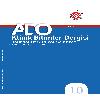TAM ve KISITLI SULAMA KOŞULLARINDA PAMUK (Gossypium hirsutum L.) DÖL SIRALARININ VERİM ve LİF KALİTE ÖZELLİKLERİNİN KARŞILAŞTIRILMASI
Bu çalışma F5 generasyonunda tek bitki döl sıralarının tam ve kısıtlı sulama koşullarında verim, verim
komponentleri ve lif kalite özelliklerinin belirlenmesi amacıyla yapılmıştır. Deneme Adnan Menderes
Üniversitesi Ziraat Fakültesi uygulama alanında tam (%100) ve kısıtlı (%50) sulama koşullarında yürütülmüştür.
Tam sulama denemesinde 124 tek bitki, kısıtlı sulama da 72 tek bitki, BA 308, Gloria, Claudia, Carmen ve Elsa
kontrol çeşitleri ile birlikte Augmented deneme desenine göre, 4 tekerrürlü olarak sıra arası 70 cm, sıra üzeri 20
cm, sıra uzunluğu 12 m olacak şekilde ekilmiştir. Tam (%100) sulama koşullarında incelenen tüm özellikler
bakımından, kısıtlı sulama (%50) koşullarında ise bitkide koza sayısı ve kütlü pamuk verimi yönünden genotipik
farklılığın önemli olduğu saptanmıştır. Bu çalışma sonucunda tek bitki döl sıraları; verim, verim komponentleri
ve lif kalite özellikleri bakımından birlikte değerlendirildiğinde, tam sulama koşullarında, Carmen x Nazilli-503
(H: 11), Nazilli-503 x Şahin-2000 (H: 109), Carmen x Nazilli-503 (H: 119), ST-373 x DPL-90 (H: 122), kısıtlı
sulama koşullarında ise Carmen x Nazilli-503 (H: 20), Nazilli-503 x Tamcot-22 (H: 61), Carmen x DPL-90 (H:
75) tek bitki döl sıraları ümit verici döl sıraları olarak saptanmıştır.
Anahtar Kelimeler:
Pamuk (Gossypium hirsutum L.), verim, melez populasyonu, su stresi
___
- Asadi R, Kohi N, Tavassoli A (2011) Effect of irrigation regime and method of strip irrigation system on yield, yield components and water use efficiency of cotton under drought stress conditions of Orzouiyeh region of Kerman province in Iran. Scientific Research and Essays, Vol. 6(27), pp. 5812-5819.
- Basal H, Dagdelen N, Unay A, Yılmaz E (2009) Effects of deficit drip irrigation ratios on cotton (Gossypium hirsutum L.) yield and fiber quality. J. Agron. Crop Sci., 195: 19-29.
- Ceccarelli S (1996) Positive interpretation of genotype by environment interaction in relation to sustainability and biodiversity. p. 467–486. Plant adaptation and crop improvement. Editör: Cooper M.,Hammers G.L. Wallingford UK.
- Karademir Ç, Karademir E, Gençer O (2011) Yield and fiber quality of F1 and F2 generations of cotton (Gossypium hirsutum L.) under drought stress conditions, Bulgarian Journal of Agricultural Science, 17 (6): 795-805 pp.
- Krieg DR (1997) Genetic and environmental factors affecting productivity of cotton. Proc. BeltwideCottonProd. Res. Conf. p: 1347.
- Lokhande S, Reddy K (2014) Reproductive and Fiber Quality Responses of Upland Cotton to Moisture Deficiency. Agron. J. Vol. 106, No. 3, p. 1060-1069.
- McWilliams D (2004) Drought strategies for cotton. Cooperative Extension Service Circular 582 College of Agricultureand Home Economics. http://www.cahe.nmsu.edu/pubs/circulars. Son erişim tarihi: 15 Ekim 2011.
- Mert M (2005) Irrigation of cotton cultivars improves seed cotton yield, yield components and fibre properties in the Hatay region, Turkey. Acta Agriculturae Scandinavica, B,. 55: 44-50.
- Özkara M, Sahin A (1993) Ege Bölgesinde Farklı Sulama Programlarının Nazilli-84 ve Nazilli-87 Pamuk Çesidinin Verim ve Bazı Kalite Özelliklerine Etkileri. Menemen Araştırma Enst. Md. Yayınları, Genel Yayın No:193, s. 58, Menemen.
- Papastylianou P, Argyrokastritis I (2014) Effect of limited drip irrigation regime on yield, yield components, and fiber quality of cotton under Mediterranean conditions. Agricultural Water Management, Vol. 142, p. 127-134.
- Petersen RG, Calvin LD (1965) Sampling. In: Black CA, Evans DD, White JL, Ensminger LE, Clark FE (Eds.), Methods of Soil Analysis Part 1. American Society of Agronomy, Madison, Wisconsin, USA, pp. 54–72.
- Pettigrew WT (2004) Moisture deficit effect on cotton lint yield, yield components, and boll distribution. Agron. J., 96, 377–383.
- Quisenberry JE, Roark B, Fryrear DW, Kohel RJ (1980) Effectiveness of selection in uplan dcotton in stres environments. CropSci, 20,450–453.
- Rai E (2011) Mechanism of Drought Tolerance in Cotton- Response of Cotton Cultivars to Irrigation in The Texas High Plains. Master of Science, Texas Tech University. USA. pp:97, Texas.
- Ritchie GL, Bednarz CW, Jost PH, Brown SM (2004) Cotton growth and development. Cooperative Extension Service and The University of Georgia College of Agricultural and Environmental Sciences. Bulletin, 1252.
- Rosielle AA, Hamblin J (1981) The theoretical aspects of selection for yield in stres and non-stress environments. Crop Sci., 21,943– 946.
- Shakoor MS, Malik TA, Azhar FM, Saleem MF (2010) Genetics of agronomic and fiber traits in upland cotton under drought stress. Int. J. Agric. Biol., 12: 495–500. Stiller WN, Reid PE, Constable GA (2004) Maturity and leaf shape as traits influencing cotton cultivar adaptation to dry land conditions. Agron. J., 96, 656–664.
- Türkeş M (2008) Gözlenen iklim değişiklikleri ve kuraklık: Nedenleri ve geleceği. Toplum ve Hekim, 23:97-107.
- ISSN: 1304-7787
- Yayın Aralığı: Yılda 2 Sayı
- Başlangıç: 2004
- Yayıncı: Adnan Üniv. Ziraat Fak.
Sayıdaki Diğer Makaleler
Hatice YAVUZ, Ali YİĞİT, Osman EREKUL
SİMMENTAL YETİŞTİRİCİLİĞİNİN DEĞERLENDİRİLMESİ: 1. DÜNYADA ve TÜRKİYE'DEKİ YETİŞTİRİCİLİĞİ
SİMMENTAL YETİŞTİRİCİLİĞİNİN DEĞERLENDİRİLMESİ: 2. TÜRKİYE’DEKİ ÇALIŞMALAR
ÇÖREK OTU (Nigella sativa L.)'NDA FARKLI EKİM ZAMANI ve TOHUMLUK MİKTARININ VERİM ve KALİTEYE ETKİSİ
Hüseyin BAŞAL, Talih GÜRBÜZ, Hatice Kübra GÖREN
AYDIN'DA KARASU SORUNU ve ZEYTİNYAĞI İŞLETMELERİNİN ÇÖZÜME YÖNELİK TERCİHLERİNİN İNCELENMESİ
Ruşen YILDIRIM, Renan TUNALIOĞLU
TÜRKİYE'DE GIDA GÜVENCESİNİN MEVCUT DURUMUNUN DEĞERLENDİRİLMESİ
